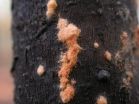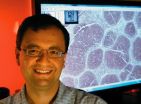A new research finding showing a strong relationship between complex microbial ecologies in human intestines and the common but serious medical condition known as fatty liver illustrates this paradox.
From past genomic studies, we have learned that a mind-boggling multitude of different kinds of benign bacteria inhabit our intestines and that these populations can vary almost infinitely from one human being to the next. We know that the kind of food we eat is important to our health and we know that having the right bacteria in our intestines is important in digesting our food properly, but we still do not know how our individual variations in gut bacteria might influence more specific health issues. In particular, we do not know how these bacteria influence how the substances we eat affect our organ systems.
In the condition known as fatty liver, fat deposits build up in the liver, with potentially serious health consequences for nearly a third of the American population. Fatty liver can be caused by alcohol abuse, obesity, hormonal changes and/or diabetes. Recent work has suggested that diet is also important with strong indications that deficiencies in the essential nutrient choline might be partially involved in some incidences of the condition. Choline deficiency also implicates genetics, since many people lack the genes to efficiently make choline internally.
Now, a new bioinformatics finding shows that the abundance or scarcity of certain types of bacteria in the gut may also help predict susceptibility to non-alcoholic fatty liver. The implication of the finding is that these groups of bacteria may be influencing the body's ability to properly use the choline available in food, though the study does not examine the specific metabolic activity of the bacteria involved.
In a metagenomic analysis of the microbial communities living in the intestinal tracts of 15 female patients participating in a study of the effects on liver condition from a choline-depleted diet, bioinformatics researchers at the University of North Carolina at Charlotte found a strong correlation between the relative abundances of two specific classes of bacteria and the development of fatty liver. A report on the finding appears in the current issue of the journal Gastroenterology.
"Certain bacterial populations correlated very strongly with increased fat in the liver during a restricted choline diet," said Melanie Spencer, a doctoral student in bioinformatics at the University of North Carolina at Charlotte and the lead author on the paper. "To us, it's an amazing result because you just don't see this clear a correlation in biological experiments in humans very often."
The authors on the paper are Spencer, Anthony Fodor, Timothy Hamp and Robert Reid from the department of bioinformatics and genomics at UNC Charlotte, as well as Steven Zeisel and Leslie Fischer from the department of nutrition at the University of North Carolina at Chapel Hill.
Using a metagenomic technique that compares versions of a ribosomal RNA gene known to vary between bacterial groups, the researchers analyzed the genomes of the patients' gut bacteria before, during and after the patients were put on a choline deficient diet. Because all patients consumed identical diets during the study, the researchers predicted that the initially distinct and complex communities of microbes in the patients' intestinal tracts would react by becoming less distinct from each other. The researchers found instead that, though each of the patients' bacterial communities did change a bit, each individual's community still remained distinctive throughout the study.
"What we expected we might find would be that when we put the patients on exactly the same diets, everyone's gut microbe mixture would begin to look similar, with the microbial communities converging. It did not happen – everybody was clearly individual throughout the entire study," Spencer noted.
"So we also looked at how the patients' microbes actually changed in pattern, even though they remained distinct from each other," she said. "The patterns of change were very interesting. Some of the patterns were very distinct in themselves."
The researchers noticed that among the numerous classes of bacteria present in each patient, variations in the populations of two particular groups seemed to correspond with variations between patients in the degree to which they developed a fatty liver during the period of dietary choline depletion.
"Those patients with the highest abundance of Gammaproteobacteria at the beginning of the study seemed to have the lowest fatty liver development. The ones with the least developed the most fatty liver," Spencer noted. "Erysipeoltrichi showed exactly the opposite association, though this relationship was not quite as strong. So there seemed to be change going on in opposite directions."
When the trends of Gammaproteobacteria abundance and Erysiptoltrichi scarcity were combined and related to fatty liver development, the relationship became even stronger.
Finally, the researchers factored in individual genetic variations that affect internal production of the nutrient choline and that should explain why some patients developed fatty liver and others did not. Surprisingly, the results showed that each person's genetics did not entirely account for their fatty liver outcome. When the researchers modified the analysis to include the abundances of the two bacterial groups and each individual's genetics, the correlation between fatty liver development and these three factors was nearly perfect. Further mathematical tests were performed to show that the correlations were not likely to be an artificial result of some bias hidden in the analysis.
"There was some concern that we were 'over-fitting' the model," Spencer noted, "so we tested it out and ran a million permutations, altering the bug abundance and subject association, to see if we could identify how many actually showed a higher correlation by chance. What we found is that the p values still held up. We can have a lot of confidence in the result."
The big question that remains for the team is why the two bacterial populations correlate so strongly to the development of fatty liver. Anthony Fodor, UNC Charlotte assistant professor of bioinformatics and the project's director, sees a possible explanation, while warning against drawing specific conclusions without further study.
"We cannot yet assign cause and effect, but it implies that some bacteria are doing something that is making it easier for people to deal with a choline deficiency and for the liver to metabolize fat."
Conversely, the bacteria whose high population levels correlate with disease may be somehow removing available forms of choline from digested food. Fodor explains that further study will be needed to answer those questions.
"We're debating what the next step is," he said. "In some ways, this is a very specialized experiment because we are inducing fatty liver in a very specific way. In the general population, fatty liver is induced in many, many ways and not everyone who has fatty liver has low choline.
"It's probably like Alzheimer's or cancer, where there are many different causes for a disease that displays a common phenotype. More research will be required to determine the extent to which bacterial populations play a role in fatty liver development in the general population, but our results strongly suggest that there may be a link in some people."
###
The article is available online at http://www.gastrojournal.org/article/S0016-5085(10)01739-7/fulltext (fee required for access) or contact jbhathaw@uncc.edu for a copy.
Sources: Anthony Fodor, 704-687-8214
Melanie Spencer, 704-364-6215
END


